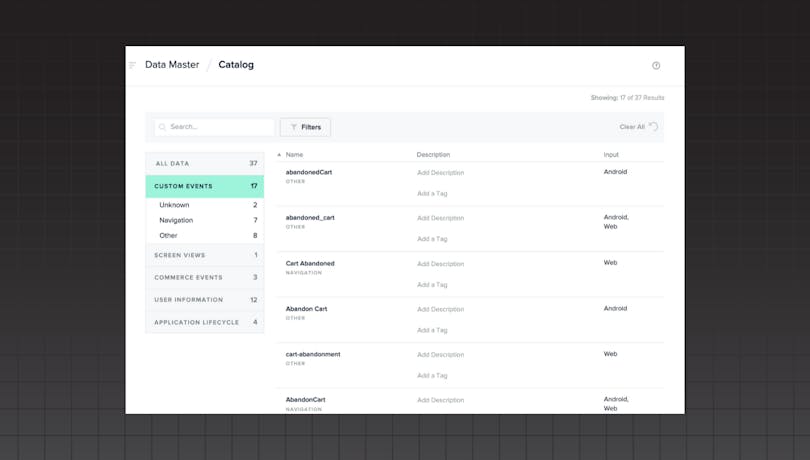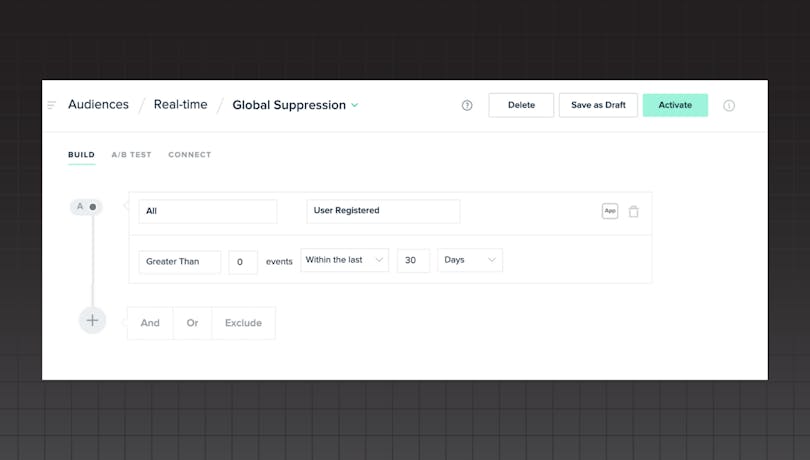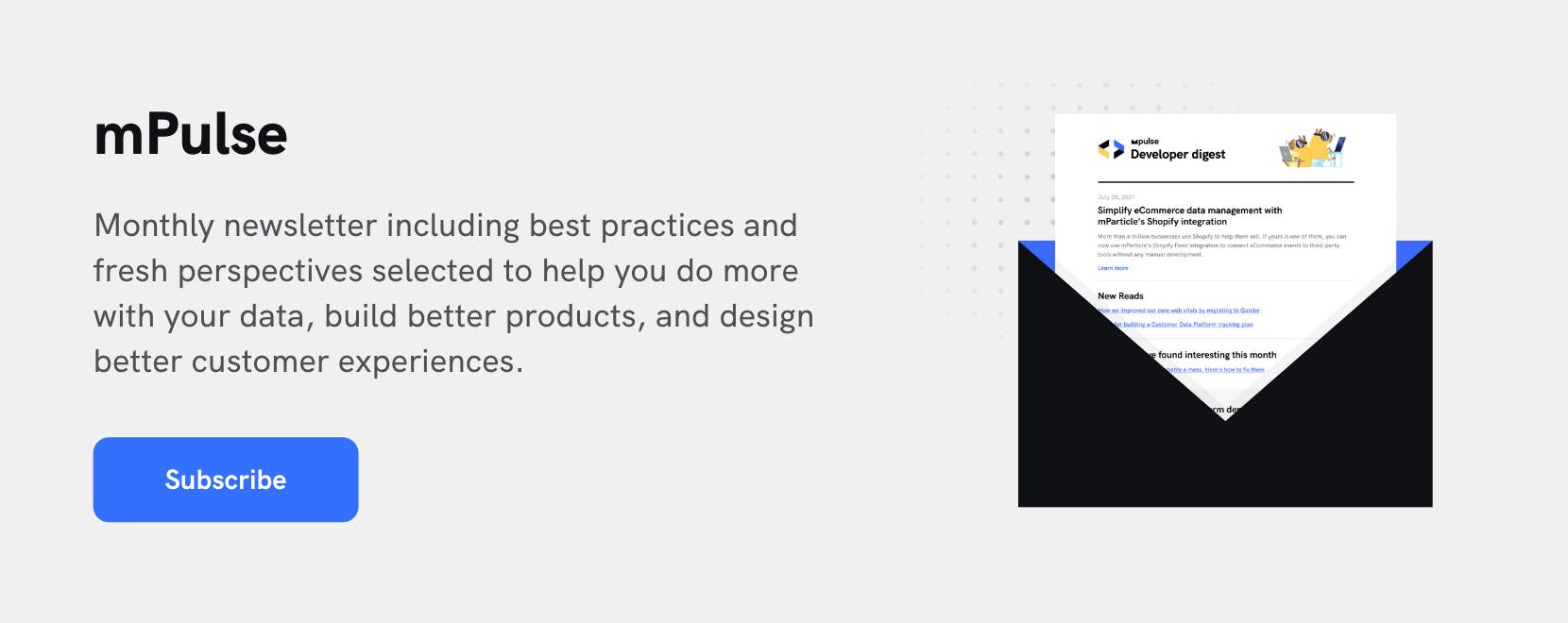3 data strategies for high-growth companies
As an mParticle CSM, it’s my job to help brands develop and implement a customer data strategy to drive growth. Here’s what I’ve seen work across industries and organizations.

Building a good product the market cares about is really tough. Unfortunately, once you have accomplished that milestone, growing from an idea to a scaled business is not easy either!
As a brand acquires more customers, or expands usage in a new channel, it often experiences growing pains that make it difficult to continually expand. Further, the challenges faced acquiring the first thousand users will be drastically different from those faced gaining the next ten thousand, not to mention the next ten million. Some of these difficulties are external — keeping up with market preferences, technology shifts, competitors, etc.—but many are internal. Factors like bad data quality, slow speed to market, limited access to technical resources, and product instability can all stall growth.
At mParticle, we work with some of the most high-growth companies in the world, such as Spotify, Airbnb, Postmates, and Venmo, to ensure that their infrastructure is stable enough, and that their team can move quickly enough, to execute data-driven initiatives at scale.
In my role as a Customer Success Manager (CSM), I partner with our customers’ data-driven teams to assist in technical/business strategy, data planning, and the orchestration of the tools in their growth stack. Every mParticle customer, whether an omnichannel enterprise brand or a high-growth, mobile-first startup, receives a dedicated CSM and Solutions team to support them. It’s my job to make sure that, as a Customer Data Platform, we’re doing everything we can to make it easier for our customers to do more with their data at scale.
Throughout the many clients I’ve worked with, there have been several key challenges that, once overcome, have allowed brands to reach new levels of growth. This post will walk through each, with the aim of providing key insights that you can apply to your growth strategy.
Managing data quality
It isn’t the jazziest thing on the list, but from my experience working with dozens of brands, managing data quality is definitely the most important factor in the pursuit of growth. Without a system in place to manage data quality, I’ve seen clients struggle to identify which data points to activate across web, mobile, and backend servers, forcing them to rely on data engineers to maintain naming conventions.
One of my clients was trying to execute a simple abandoned cart campaign across email, push, and SMS channels. To execute this, they looked to build an Audience segment of all users who added items to their cart but did not complete the purchase within 48 hours. When building the audience logic, however, the team discovered over eight abandoned cart event variants. They had no clue which of these events should be used as the basis of their campaign, leading them to lean on data engineering to resolve the data quality issue.

The engineering team uncovered that the abandoned cart data point was named differently across iOS, Android, and Web, and that different versions of the mobile app had different naming conventions. The team had to delay their campaign by two business quarters, engineering had to dedicate dozens of hours to manual data cleansing, and product had to force an update on all their mobile users.
According to an industry survey, 69% of online purchasers abandon their cart. 45% of these users will open an abandoned cart email, and 10.7% overall convert into a purchase. To put this delay in perspective, for a business that generates $1M/month in eCommerce revenue, a push of 6 months due to data quality issues results in $642,000 loss in revenue.
With a system in place to manage data quality, on the other hand, brands are able to trust their user profiles and segments and get to market much faster. Data engineers are able to spend less time maintaining data consistency and return to core development. To manage data quality, it’s critical to:
- Make sure your team is operating on a unified data plan, with consistent naming conventions across systems
- Share and collaborate on data plans with teams from across the organization, to ensure that everyone has access to the same
- Identify and address unplanned and invalid data points that don’t conform to your schema with data quality enforcement rules and validation reporting
- Adapt your data as business initiatives change over time
Audience suppression across channels to reduce CAC
Social media platforms have made it easier than ever to get your message in front of potential customers, but it comes at a price. To sustain growth over time, it’s critical to acquire users while keeping your Customer Acquisition Cost (CAC) under control.
One of my clients was tasked with driving app downloads with a fixed advertising budget. To maximize return on investment (ROI), they aimed to reduce customer acquisition costs (CAC) across channels. There are of course a number of ways to potentially reduce CAC, but one that is oft overlooked is real-time suppression targeting.
To maximize reach, the social media advertising team had to invest across a number of networks, including Facebook (Instagram), Google Ads, and Snapchat. Because mParticle records app installs and registrations in real time, the team was able to set up an audience segment that immediately suppressed registered users from being targeted across social media channels.

Audience suppression is not new to anyone, of course, but as Instagram, Snapchat, and Google Ads do not share conversion metrics with each other, the marketing team estimated that mParticle’s ability to suppress converted users in real time, agnostic of which channel they converted from, allowed them to invest strategically and saved almost 30% of their user acquisition budget.
When running audience suppression across channels, it’s critical to:
- Make sure you’re able to keep audience segments up-to-date in real-time
- Sync audiences across activation channels, especially if working with walled gardens
- Track CAC and other target metrics to measure impact
Data independence for marketing
It isn’t the big companies that eat the small, it’s the fast that eat the slow. This is an axiom that I’ve seen hold true across a number of industries and businesses and couldn’t be more relevant to marketers and product managers working at high-growth brands.
One of the largest growth accelerators I’ve seen is the ability for non-technical stakeholders to action on customer data in a codeless environment without needing to rely on engineering and data teams (who are often inundated with a backlog of other requests) for access to customer data.
One recent example of this was an online marketplace that was trying to run a coordinated “last minute flash sale” campaign across email, push, and sms based on what a given user viewed over a three-day period, Wednesday–Friday, on either the website or mobile app. The marketing team also needed to send the message to this target audience within a 2 hour window on Saturday to ensure that these users had an opportunity to convert over the weekend. Instead of filing separate requests to query this data from the web and mobile teams and waiting weeks for the results, the marketing team was able to collect and orchestrate the data in real time. This allowed the team to identify unique users across web and mobile and generate the list of target users within a matter of hours. Moreover, because this list was maintained in real time, by the time Saturday rolled around the users who had qualified to get the offer/notification earlier in the week but had since converted were excluded from the campaign. With the team able to stay agile and get to market quickly, the campaign generated a 15% increase in sales.
By decoupling marketers’ reliance on data teams to gain access to customer data, brands are able to capitalize on market opportunities in real time. To ensure that non-technical teams can be independent and agile, it’s critical to:
- Provide a hub where non-technical teams can quickly segment and execute on customer data in a codeless environment.
- Centralize customer data across sources: mobile, web, instore, server side, etc.
- Make sure they can connect user events and audience segments to their favorite tools without depending on technical support for implementation and list building.
When making changes to drive growth, the means are just as important as the methods. Investing in the right technology partners makes the process of introducing cross-functional systems and influencing organizational change much easier. At mParticle, we’re proud to provide the data infrastructure for worlds’ most innovative brands, helping to accelerate their growth. To learn more, you can explore our data-driven personalization features here.
Are you a startup leader trying to take your company to the next level of growth? mParticle is now free for startups for one year. Learn more about our Accelerator Program here.
Latest from mParticle
Try out mParticle
See how leading multi-channel consumer brands solve E2E customer data challenges with a real-time customer data platform.
Startups can now receive up to one year of complimentary access to mParticle. Receive access





